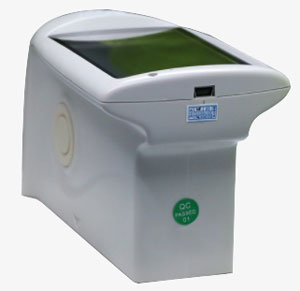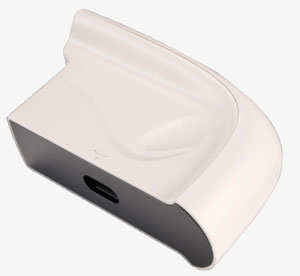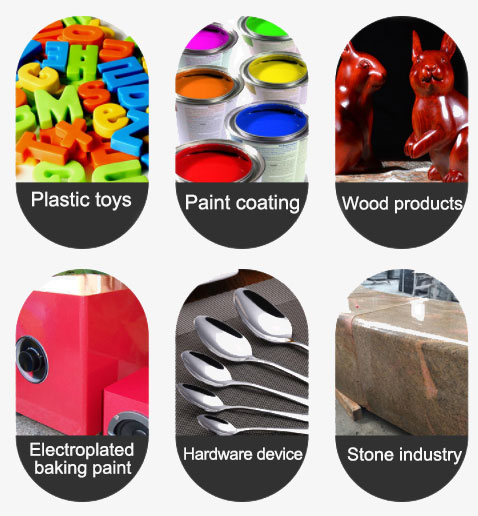Digital gloss meter built-in rechargeable battery, with automatic shutdown function, economic and environmental protection, repeat accuracy 0.1 ~ 0.2% GU, power supply 3.7V 3200mA battery, support USB interface to connect to PC, RS-232 to connect to printer.

Measurement button
- The ergonomic design of the measurement button is on the right side of the machine.
- Make sure the calibration plate is clean before calibration, and check if the SN code is the same as the instrument.

Measurement spot
- Measuring spot 9x15 mm, 60° measurement, gloss meter can measure most applications.
- The gloss meter has stable performance, the range is 0~300GU, and it can measure low gloss.
Application
Gloss meters are used for floor maintenance, quality control of surface cleaning, gloss measurement of stones and tiles, an inspection of painted objects, quality control of paints, inks, and polished metal surfaces, an inspection of paint protection layers, wax films, car body paint, plastic moldings, detergents, scrubbers, masonry, evaluation of building exteriors.
| Model | SISCO-GM-HG60 |
| Measuring Angle | 60° |
| Measuring Range | 0~300 GU |
| Measuring Spot Area | 9 x 15 mm |
| Division Value | 0.1 GU |
| Repeatability | 0-10 GU: ± 0.1 GU 10-100 GU: ± 0.2 GU 100-300 GU: ± 0.2% GU |
| Reproducibility | 0-10 GU: ± 0.2 GU 10-100 GU: ± 0.5 GU 100-300 GU: ± 0.5% GU |
| Chromaticity Corresponding | Corresponding with CIE 1931 (2°) under CIE C light source |
| Errors | ± 1.5, ± 1.5% |
| Measuring Time | 0.5s |
| Dimension | L*W*H 160mm*75mm*90mm |
| Weight | 350g |
| Battery | 3.7V, 3200mAh Li-ion Battery, >10000 times (within 8 hours) |
| Display | TFT 3.5 inch |
| Interface | USB/RS-232 |
| Storage | Basic mode: 1000 |
| Software | GQC6 Quality Control Software with QC report printing functions and more extended functions. |
| Operation Temperature | 0~40℃ (32~104℉) |
| Storage Temperature | -20~50℃ (-4~122℉) |
| Humidity | <85% relative humidity, no condensation |
| Standard Accessories | Power adapter, USB cable, user manual, GQC6 software CD, calibration plate |
| Optional Accessories | Miniature printer (Please contact us if you need one) |
A1: What is a gloss meter?
Q1: Gloss meters are used to measure the surface gloss of materials. A gloss meter is used to measure the reflectance of light on the surface of an object, that is, the specular gloss. Depending on the angle of incidence selected during measurement, the results are also different. The larger the angle of incidence, the higher the specular reflectance, the higher the gloss, and vice versa.
A2: What are the measurement angles of the gloss meter?
Q2: Gloss meter, mainly contains three measuring angles, respectively 20 °, 60 °, and 85 °, different measuring angles for different glossy object surfaces.
A3: How to choose the measuring angle of the gloss meter?
Q3: For different object surfaces, the suitable measurement angle is not the same, general materials, generally use a 60 ° gloss meter can be measured, high gloss materials, you can choose a 20 ° gloss meter, for low gloss materials, you can choose 85 ° gloss meter.
Tips: Notes on using sisco gloss meter
- The sisco gloss meter is a precision measuring instrument. During measurement, avoid drastic changes in the external environment of the gloss meter. For example, avoid flickering of ambient light, rapid temperature changes, etc. during measurement. When measuring gloss, keep the gloss meter stable, and the measurement port should be close to the object to be measured to avoid shaking and shifting.
- The gloss meter is not waterproof and cannot be used in high-humidity environments or in water mist.
- Keep the gloss meter clean and tidy. Avoid liquid, powder or solid foreign objects such as water and dust from entering the measuring aperture and the inside of the instrument.
- Avoid collision with the gloss meter.
- Turn off the gloss meter in time after use, and keep the gloss meter and calibration plate properly.
- The gloss meter should be stored in a dry and cool environment.
- Users are not allowed to change the gloss meter without authorization. Any unauthorized changes may affect the accuracy of the gloss meter or even cause irreversible damage.
Thank you for buying industrial test and measurement equipment on SISCO.com, all products sold by SISCO and the partner cover a 12 months warranty, effective from the date of receiving the products.
What is covered?
SISCO is responsible for providing free spare parts, and free technical support to assist the customer to repair the defective products until the problem is solved.
What is not covered?
- Product purchased from anyone other than a SISCO store or a SISCO authorized reseller.
- Expendable parts.
- Routine cleaning or normal cosmetic and mechanical wear.
- Damage from misuse, abuse or neglect.
- Damage from use of parts other than SISCO approved.
- Damage from use outside the product’s usage or storage parameters.
- Damage from use of parts not sold by SISCO.
- Damage from modification or incorporation into other products.
- Damage from repair or replacement of warranted parts by a service provider other than a SISCO authorized service provider.
- Damage caused by the application environment not meeting the product usage requirements and the failure to perform preventive maintenance.

